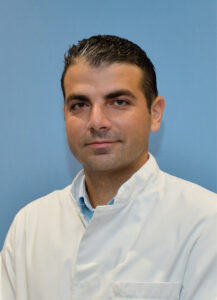Endometriosis affects almost 1/6 women worldwide, often passing unnoticed or delayed. On the occasion of March, which has been established as a month of awareness for endometriosis, let’s look at exactly what this disease is, how it affects women’s daily lives and what are the latest developments in its diagnosis and treatment.
What is endometriosis?
Endometriosis is a condition where the tissue that normally invests the interior of the uterus (endometrium) develops in other parts of the body, such as the ovaries, the fallopian tubes or other pelvic organs. This displaced tissue responds to the hormonal changes of the menstrual cycle, causing inflammation and outbreaks of pain.
Although it is mainly observed in women of childbearing age, it can be diagnosed with young girls who have just begun menstruation or even after menopause.
What are the symptoms of endometriosis?
- Intense pain during menstruation (dysmenorrhea): Many women with endometriosis report pain before and during the period, which may extend to the waist or pelvis.
- Chronic pain in the pelvis: Pain can rarely occur throughout the cycle, not just on the days of the period.
- Pain in sexual intercourse: Endometriosis often leads to annoyance or pain during or after sex, negatively affecting sex life.
- Difficulty: The disease is associated with infertility due to inflammation or damage to organs such as the ovaries and the fallopian tubes, as well as to an immune reaction of an unknown mechanism.
- Bowel or bladder disorders: In rare cases, there may be symptoms, such as bleeding in emptying or urinating, especially during the period.
How is endometriosis diagnosed?
Clinical examination and taking a detailed history are the first steps. Usually, intermittent ultrasound is recommended to control any cysts or other suspicious indications of endometriosis. However, endometriosis outbreaks in peritoneum or other organs do not appear in the ultrasound or even magnetic resonance imaging, as they may be very small or non-admirers.
In fact, the definitive diagnosis of endometriosis It is histological, that is, accurate confirmation is done by laparoscopy. It is a minimally invasive surgical method, where the doctor directly examines the internal organs with a special camera and receives tissue samples for examination.
Why do many women ignore their symptoms?
Mostly, due to the lack of information on the disease, both on the part of patients and on the part of the doctors, they mediate on average 10.4 years between the onset of symptoms and diagnosis. During this time, patients experience at least one incorrect diagnosis. As the symptoms may be quite in general, incorrect diagnoses, such as irritable colon or inflammatory pelvic disease, are common. In addition, many women consider severe pain of the period “normal” and do not seek medical help, while endometriosis may have mild or no symptoms, resulting in unnoticed for years. Timely and proper diagnosis helps to treat symptoms and improve quality of life.
What treatment options are there?
OR treatment It depends on the clinical picture, the age of the woman and her desire to have children. Some basic approaches include:
- Medication: Hormonal preparations (eg specific contraceptive categories) are usually administered in a continuous cycle to reduce endometrial growth and pain. However, aggressive drug treatment with injections that “put” women in premature menopause is not recommended, as it has significant side effects for the body and the patient’s psychology.
- Surgery: Laparoscopy enables the abstraction and/or destruction of endometriosis. In advanced stages or deep endometriosis, robotic surgery can provide significant advantages for the patient, thanks to high accuracy and better tissue handling, providing less blood loss and faster recovery. As in advanced forms of endometriosis incidents in pelvic nerves, intestine, diaphragm, ureter and bladder, the treating physician must be ready to deal with such situations using laparoscopic or highly specialized laparoscopic techniques.
Access to specialized gynecologists is critical, as it can substantially contribute to radical cleaning of the disease and proper management of post -operative strategy to avoid recurrence. Possible cleansing of the disease in a first surgery can significantly make it difficult to make a second complementary surgery due to adhesions, while increasing the likelihood of complications.
The decision on surgical or exclusively pharmaceutical treatment is taken in collaboration with the physician, taking into account the severity of the symptoms, the desire for childbirth and the age of the patient. At the same time, supportive treatments, such as physiotherapy, changes in nutrition (avoidance of sugar) and psychological support, can contribute to the overall improvement of everyday life.
March and endometriosis
March has been internationally established as a month of awareness for endometriosis. The aim is to inform women, their families and the wider public about the symptoms, consequences and available therapies of the disease. With speeches, seminars and campaigns, the “opening” of the discussion of a problem that often remains secret is encouraged.
How can we contribute to raising awareness?
- Share information: Find out from reliable sources and promote knowledge to friends and relatives.
- Support actions: Take part in informative events and online campaigns.
- Encourage the conversation: If you have symptoms or know someone who is suffering, urge her to seek medical advice.
Endometriosis is not just “severe period pain”, but a chronic condition that can seriously affect female health and fertility. Early diagnosis, histological confirmation through laparoscopy, personalized treatment and proper information are the key “keys” to its effective treatment. March reminds us that only through open discussion and support can we encourage more women to seek the care and treatment they need, effectively improving their quality of life.

Written by Dr. George LandObstetrician-Gynecologist-Oncologist Obstetrician Gynecology Clinical Oncology and Robotic Surgery, Medical Inter -Balkan Thessaloniki
Read more articles on issues related to your health, here
